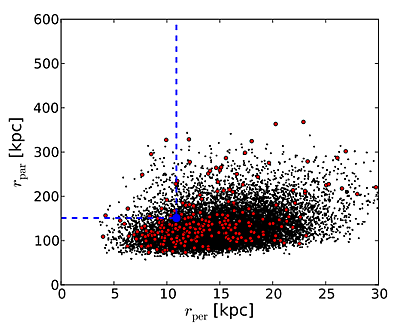How do galaxies get their gas is a key question for better understanding the formation and evolution. In the conventional picture, the cold gas is accreted onto the dark matter halo, and is shock heated to the virial temperature of the halo. The hot gas then loses pressure support due to radiative cooling, then settles into centrifugally supported disk and begins to form stars (White & Frenk 1991). A number of theoretical and simulation-based works in the past decade, however, have found two distinct modes of gas accretion, named as hot and cold accretion (Dekel & Birnboim 2006). Cold gas flowing along dark matter filaments can be directly accreted onto the central galaxy without being shock heated. Cold stream are thought to be the main source of gas supply in galaxies especially in Milky Way like galaxies at high redshift.

By with WANG Liang
Figure1. rms distance (rpar) of the satellites projected on to their best-fittingplane plotted against the rms height (rper) of the satellites from the plane for the ‘far’ sample.
In 2014, researchers from Purple Mountain Observatory, Nanjing University and Max Planck institute for Astronomy employed a high-resolution Eulerian code using the positive preserving WENO scheme to determine the stability of cold flows under Kelvin- Helmholtz instability, Rayleigh-Taylor instability, thermal evaporation and the impact of satellites. In the model, the hot halo gas is initially set to be isothermal and in hydrostatic equilibrium under the gravitational petential of the Milky Way size dark matter halo at redshift z=2. The results of simulations show that a cold stream penetrating a hot
gaseous halo is stable against thermal convection and Kelven-Helmholtz and Rayleigh-Taylor instabilities. In other hand, under the disturbing action of a satellite (with a mass ratio of 1:33) merging with the central halo, the accretioin rate of cold gas at half of the virial radius experiences a dramatic drop for 0.5 Gyr. In this period the supply of cold gas into the central region decreases by more than 70%. However, the interaction probility between isotropically distributed stream and satellites is only 1% and the cold flow towards the halo center is able to re-establish itself in less than 0.3 Gyr. Therefore, this work confirm the cold stream are very stable against a large variety of internal and external pertubations.
This research highly supports the two modes accretion in galaxy formation theory and published on Monthly Notice of the Royal Astronomical Society Letter. The first author is Liang Wang, co-authors are Weishan Zhu, Longlong Feng, Andrea Maccio, Jiang Chang and Xi Kang.
The link of this paper is: http://mnrasl.oxfordjournals.org/content/439/1/L85
(Information Source: Purple Mountain Observatory, CAS)

